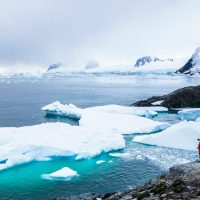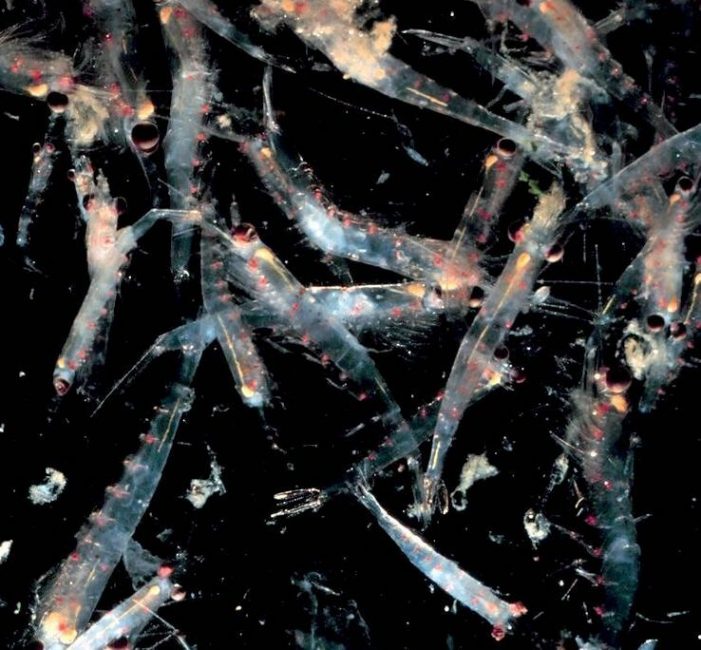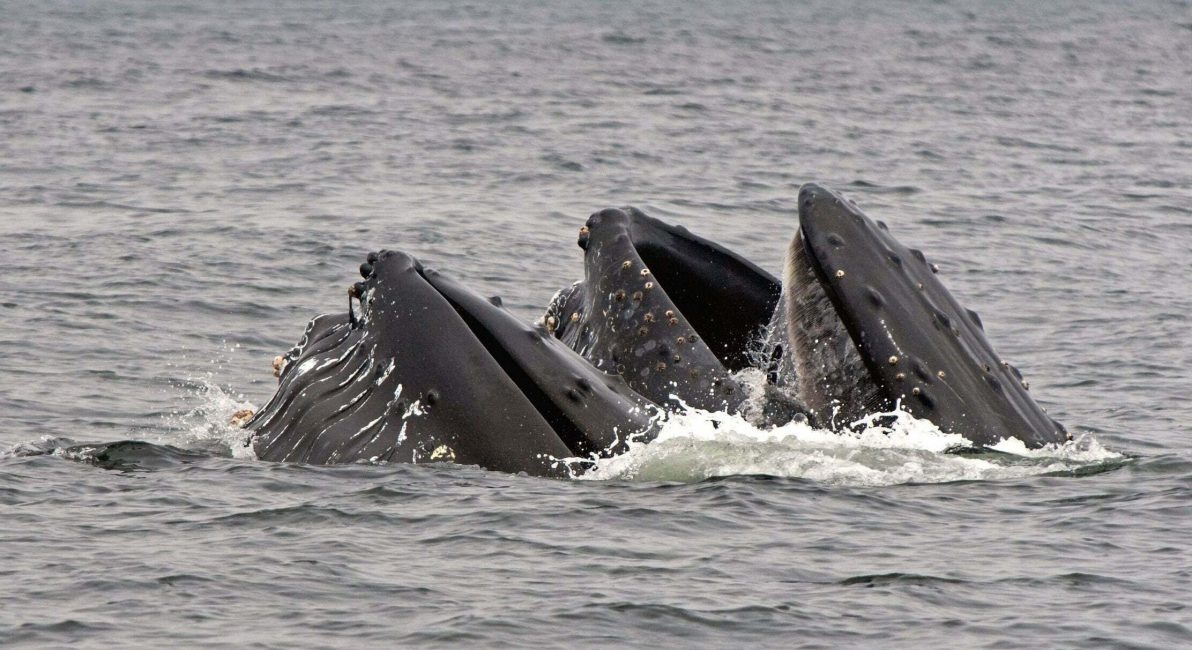Introduction
Antarctic Whales
The Southern Ocean is the Earth’s largest feeding ground for marine mammals.
Each summer a combination of cold, oxygen-rich water and powerful ocean currents gives rise to intense flurries of life. Powered by nearly 24 hours of sunlight each day, microscopic marine plants bloom in such large numbers they can be seen from space. These plants, called phytoplankton, attract swarms of tiny marine life called zooplankton, that feed on them.
The result is one of the largest, most dense concentrations of life on the planet.
It is this banquet that attracts the world’s largest whales to Antarctic waters. Many swim thousands of miles each year to dine on the riches provided by the Southern Ocean.
Two types of Antarctic whale
Antarctic Whales
There are two types of whales in the Southern Ocean: baleen whales and toothed whales.
The main differences between them are their size, what they eat and how they feed.
Read on to find out more.

ANTARCTIC WHALES
Baleen whales
There are 15 baleen whale species on Earth, six of which spend time in Antarctic waters. Learn more below.
ANTARCTIC WHALES
Baleen whales
Baleen whales are the largest whales in the world, and they have a unique method of feeding. They drift, swim and lunge through the water, scooping up mouthfuls of water mixed with Antarctic krill (Euphausia superba), copepods, small fish, and squid. Once their mouths are full they filter out the food and expel the water through their baleen, flexible plates of keratin which hang from their top jaw and work a bit like a sieve.

Southern Blue Whale
Balaenoptera musculus intermedia
The blue whale is the largest animal ever to have lived on earth. The longest blue whale ever measured was longer than a basketball court.
Read more

Southern Blue Whale
Balaenoptera musculus intermedia
The blue whale is the largest animal ever to have lived on earth. The longest blue whale ever measured was longer than a basketball court.
Scientific name: Balaenoptera musculus intermedia.
Average length: 88 feet (27 meters).
Maximum recorded length: 98 feet (29.9 meters).
Average weight: Female – up to 300,000 pounds (136,000 kg); Male – 240,000 pounds (108,000 kg).
Average lifespan in the wild: 80-90 years.
IUCN Red List status: Endangered, population increasing (2018).

Fin Whale
Balaenoptera physalus
Fin whales are the second-largest whale species – and mammal – on the planet. They can be identified by a large white patch on their lower right jaw.
Read more

Fin Whale
Balaenoptera physalus
Fin whales are the second-largest whale species – and mammal – on the planet. They can be identified by a large white patch on their lower right jaw.
Scientific name: Balaenoptera physalus.
Average length: Female – 73 feet (22 meters) ; Male – 70 feet (21 meters).
Average weight: 45 tons.
Lifespan in the wild: 60-100 years.
IUCN Red List status: Vulnerable, population increasing (2018).

Southern Right Whale
Eubalaena australis
Each southern right whale has unique callosities (raised white patches) on their heads, which act like a fingerprint.
Read more

Southern Right Whale
Eubalaena australis
Each southern right whale has unique callosities (raised white patches) on their heads, which act like a fingerprint.
Scientific name: Eubalaena australis.
Average length: 56 feet (16 meters).
Average weight: 176,000 pounds (80,000 kg).
Lifespan in the wild: 60-100 years.
IUCN Red List status: Least concern, population trend unknown (2017).

Sei Whale
Balaenoptera borealis
Sei whales reach sexual maturity by 10 years of age, but it may be 25 years before they reach their full adult size.
Read more

Sei Whale
Balaenoptera borealis
Sei whales reach sexual maturity by 10 years of age, but it may be 25 years before they reach their full adult size.
Scientific name: Balaenoptera borealis.
Average length: Female – 49 feet (15 meters); Male – 46 feet (14 meters).
Average weight: 44,000 pounds (20,000 kg).
Average lifespan in the wild: 50-70 years.
IUCN Red List status: Endangered, population increasing (2018).
Image credit: NOAA Fisheries

Humpback Whale
Megaptera novaeangliae
Humpback whales are among the most acrobatic and vocal whales, known for their social behavior, fin slapping and breaching displays.
Read more

Humpback Whale
Megaptera novaeangliae
Humpback whales are among the most acrobatic and vocal whales, known for their social behavior, fin slapping and breaching displays.
Scientific name: Megaptera novaeangliae.
Average length: Female – 49 feet (15 meters); Male – 42 feet (13 meters).
Average weight: 50,000-80,000 pounds (22,600-36,000 kg).
Average lifespan in the wild: 45-50 years.
IUCN Red List status: Least concern, population increasing (2018).

Antarctic Minke Whale
Balaenoptera bonaerensis
The smallest of the baleen whales, minke whales make a mysterious ‘quacking’ sound underwater, which researchers call ‘bio-duck’.
Read more

Antarctic Minke Whale
Balaenoptera bonaerensis
The smallest of the baleen whales, minke whales make a mysterious ‘quacking’ sound underwater, which researchers call ‘bio-duck’.
Scientific name: Balaenoptera bonaerensis.
Average length: 30 feet (9 meters).
Average weight: 20,000 pounds (9,000 kg).
Average lifespan in the wild: Estimated 40-50 years.
IUCN Red List status: Near threatened, population trend unknown (2018).

ANTARCTIC WHALES
Toothed whales
There are 77 toothed whale species on the planet. Four of these spend time in the Southern Ocean: orca (killer whales), sperm whales, bottlenose whales and Arnoux’s beaked whale. Learn more below.
ANTARCTIC WHALES
Toothed whales
Toothed whales, as their name suggests, have teeth! This allows them to forage on a variety of prey including fish, penguins, seals, dolphins and, in the case of some killer whales, even other whales. They seek out their prey using echolocation, and capture it using their teeth.

Killer Whale
Orcinus orca
There are five ‘types’ of killer whale in the Southern Ocean, each with a distinct preferred diet and habitat.

Sperm Whale
Physeter macrocephalus
Sperm whales are the largest toothed whale, and can dive to depths of 1.9 miles (3000 meters) foraging for giant squid. Only male sperm whales are found in Antarctica.

Southern fourtooth / Arnoux’s beaked Whale
Berardius arnuxii
Very little is known about the behavior, habits and life cycle of these extremely rare whales, which are seldom spotted alive.

Southern Bottlenose Whale
Hyperoodon planifrons
Found across the Southern Ocean from the Antarctic to the southern coasts of Australia, South Africa and South America, southern bottlenose whales are rarely sighted by humans.

ANTARCTIC WHALES
Did you know?
It is possible to identify whales by their dorsal fin (the fin on their back), and their blow (the mixture of air and water they release when they exhale).
Protecting Antarctic whales
For decades many species of large whales and seals were hunted, some to the brink of extinction. In 1982 the International Whaling Commission (IWC) introduced a moratorium on the commercial killing of all large whales, as well as the minke whale and orca.
Today Antarctic whales receive vital protection under several international agreements:

The Convention on the Conservation of Antarctic Marine Living Resources (CCAMLR)
CCAMLR is the intergovernmental organization charged with regulating fisheries and conserving marine ecosystems in the Antarctic.

Marine protected areas (MPAs)
Marine protected areas (MPAs) are scientifically proven to be the most effective way to limit damage caused by human activities and support vibrant, healthy marine ecosystems.

International Whaling Commission (IWC)
Whales in Antarctic waters are protected by international law, with a commercial catch limit of zero on all Antarctic whales.

Southern Ocean Whale Sanctuary (SOWS)
The International Whaling Commission (IWC) established the Southern Ocean Whale Sanctuary (SOWS) in 1994, to protect the summer feeding grounds of 80-90% of the world’s whales.

ANTARCTIC WHALES
Did you know?
Whales play an important role in the ‘biological carbon pump’, which transfers carbon from the atmosphere to the ocean.
A single whale can contain up to 33 tons of carbon, which remains on the seafloor for centuries after they die. Nutrients from their feces help fertilize the ocean and promote the growth of phytoplankton, which themselves absorb carbon.
Source: Pearson and others, 2022.
Challenges facing Antarctic whales
Whale populations are still recovering after centuries of commercial hunting. Despite the protections already in place, whales face many threats. Four out of six Antarctic baleen whales are considered near-threatened, vulnerable or endangered.
Read on to learn about some of the challenges facing Antarctic whales.
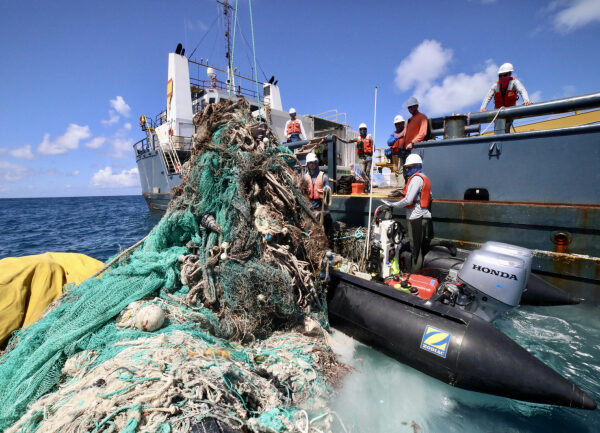
Ghost fishing gear
Abandoned, lost or discarded fishing gear (ALDFG), otherwise known as ‘Ghost Gear’, poses a threat to whales globally.
Read more

Ghost fishing gear
Abandoned, lost or discarded fishing gear (ALDFG), otherwise known as ‘Ghost Gear’, poses a threat to whales globally.
Ghost gear includes fishing nets, lines and hooks, and fish traps, which continue to “fish” after being abandoned, and which whales can become entangled in, often leading to a slow, painful death.
Whales stuck in drifting nets are unable to surface and breathe. A fishing rope tangled around the base of a whale’s tail can cut off blood circulation, resulting in the loss of the tail.
In the Southern Ocean, nearly 850 miles (1363 kilometers) of long line was abandoned, lost or discarded in only two fishing seasons. Fishing line takes around 600 years to break down. When it finally does, it disintegrates into harmful microplastics, which can be ingested by fish and crustaceans, and eventually marine mammals and humans.
Download our ghost gear infographics.
Image credit: NOAA
Sources:
Kruse et al. (2023). Plastic Debris and Its Impacts on Marine Mammals. In: Brennecke, D., Knickmeier, K., Pawliczka, I., Siebert, U., Wahlberg, M. (eds) Marine Mammals. Springer, Cham.
https://doi.org/10.1007/978-3-031-06836-2_4
Richardson et al., (2022). Global estimates of fishing gear lost to the ocean each year. Science Advances. DOI: 10.1126/sciadv.abq0135


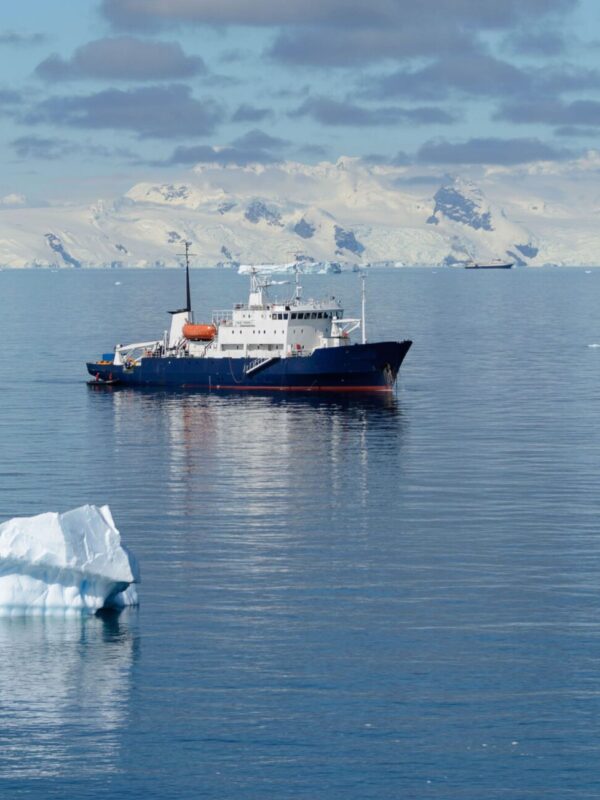
Plastic pollution
Microplastics have been detected in the blubber and tissues of whales, and a study has found that whales, particularly filter-feeding baleen whales, may be at ‘extreme risk’ of ingesting microplastics while foraging.
Read more

Plastic pollution
Microplastics have been detected in the blubber and tissues of whales, and a study has found that whales, particularly filter-feeding baleen whales, may be at ‘extreme risk’ of ingesting microplastics while foraging.
Plastic pollution is a byproduct of all shipping, including fisheries. In addition to lost or deliberately abandoned plastic ropes, lines and nets, there are numerous other sources of marine plastics. These include garbage like straws and food wrappers; gray water, which often contains microplastics; and protective coatings and paints.
Scientific research has confirmed the presence of microplastics in both Antarctic snow and the waters of the Southern Ocean.
According to the United Nations, by 2050 there could be more plastic than fish in the ocean.
Download ASOC information paper about the discharge of waste water in Antarctic Treaty waters.
Download our Plastic Pollution infographic.
Download our Microplastics from Marine Paints infographic
Sources:
Kahane-Rapport et al. (2022). Field measurements reveal exposure risk to microplastic ingestion by filter-feeding megafauna. Nature Communications 13, 6327 https://doi.org/10.1038/s41467-022-33334-5
Kruse et al. (2023). Plastic Debris and Its Impacts on Marine Mammals. In: Brennecke, D., Knickmeier, K., Pawliczka, I., Siebert, U., Wahlberg, M. (eds) Marine Mammals. Springer, Cham. https://doi.org/10.1007/978-3-031-06836-2_4
Merrill et al., (2023). Microplastics in marine mammal blubber, melon, & other tissues: Evidence of translocation, Environmental Pollution, Volume 335, 2023, https://doi.org/10.1016/j.envpol.2023.122252.

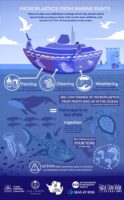

Underwater noise
Sound is a vital sense for whales. Toothed whales use echolocation to locate food and navigate, and baleen whales can communicate with one another over vast distances using vocalizations.
Read more

Underwater noise
Sound is a vital sense for whales. Toothed whales use echolocation to locate food and navigate, and baleen whales can communicate with one another over vast distances using vocalizations.
Underwater noise from shipping has a significant impact on whales, interfering with successful communication, causing stress and hearing damage, and reducing resilience to other threats.
As the number of tourism and shipping vessels increases, particularly on the Antarctic Peninsula, the potential impact on whale populations increases.
Sources:
Erbe et al. (2019). The effects of ship noise on marine mammals – A review. Sec. Marine Conservation and Sustainability. Volume 6 – 2019 https://doi.org/10.3389/fmars.2019.00606
Heise, K. (2016). The Effects of Underwater Noise on Marine Animals. Paper presented at the SNAME Maritime Convention, Bellevue, Washington, USA, November 2016.
Warren et al. (2021). Marine soundscape variation reveals insights into baleen whales and their environment: a case study in central New Zealand. R Soc Open Sci. 2021 Mar 3;8(3):201503. doi: 10.1098/rsos.201503.

ANTARCTIC WHALES
You can help
ASOC has been working to protect Southern Ocean ecosystems for over 40 years.
Join us today as we continue to lead the international conservation community in this important work.
Now that you’ve learned about whales, read on to discover more about extraordinary Antarctica.
 ASOC
ASOC
